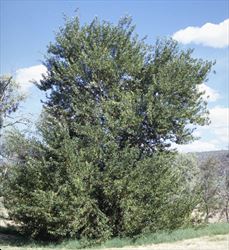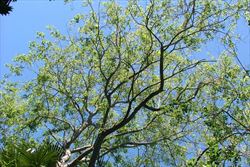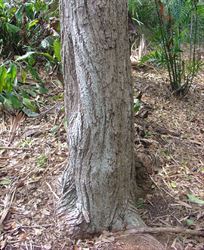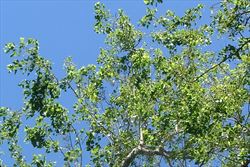Click on images to enlarge

habit (Photo: Dave Albrecht)

habit in spring (Photo: Sheldon Navie)

main trunk (Photo: Sheldon Navie)

close-up of bark on main trunk (Photo: Sheldon Navie)

young foliage (Photo: Sheldon Navie)

compound leaves and immature fruit (Photo: Dave Albrecht)

flowers, leaflet undersides and mature fruit (Photo: Dave Albrecht)

close-up of hairy younger stems and pea-shaped flowers (Photo: Dave Albrecht)
Scientific Name
Dalbergia sissoo Roxb. ex DC.
Family
Fabaceae (Queensland, the ACT, Victoria, Tasmania, and the Northern Territory)
Fabaceae: sub-family Faboideae (New South Wales)
Leguminosae (South Australia)
Papilionaceae (Western Australia)
Common Names
dalbergia, East Indian rosewood, Himalaya raintree, Indian dalbergia, Indian rosewood, penny leaf tree, penny-leaf tree, shisham, sisso, sissoo
Origin
Native to the Indian Sub-continent (i.e. Bangladesh, Bhutan, India, Nepal and Pakistan), Myanmar and possibly also western Asia (i.e. Oman, Iraq, Iran and Afghanistan).
Naturalised Distribution
Naturalised in northern, central and south-eastern Queensland and in some parts of the Northern Territory.
Also naturalised overseas in south-eastern USA (i.e. Florida).
Notes
Indian rosewood (Dalbergia sissoo) is regarded as an environmental weed in the Northern Territory and in some parts of Queensland. In the Northern Territory, it grows mostly on sands and gravels along watercourses, sometimes spreading out into the nearby drier forests and plains. It has also formed dense thickets on sand dunes near Darwin harbour, and there are scattered infestations elsewhere in the city.
This species is also becoming a widespread woody weed in remnant vegetation around Mackay (e.g. it is the most important weed problem in the Slade Point Wetlands). Because it suckers prolifically, it has the potential to form dense thickets that replace native vegetation. It can also reduce the productivity of grazing areas and deny access to waterways and coastal areas.

